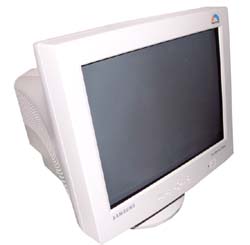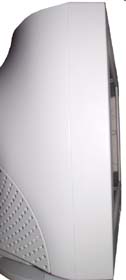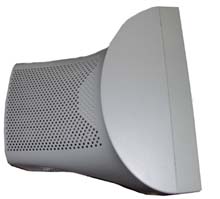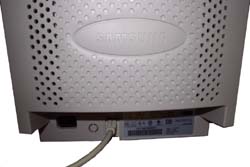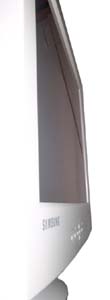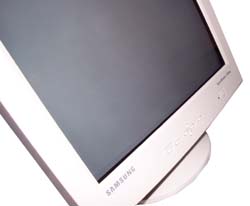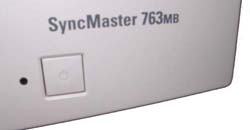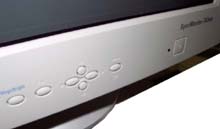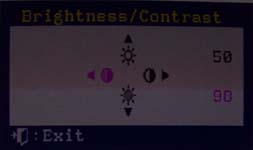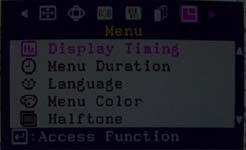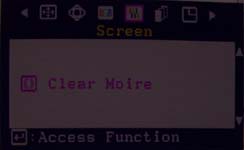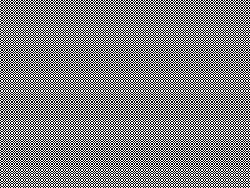
Original Link: https://www.anandtech.com/show/1022
Samsung SyncMaster 763MB 17'' CDT: Affordable Flatscreen
by Kristopher Kubicki on October 30, 2002 2:42 AM EST- Posted in
- Displays
Introduction
We have taken several looks at Samsung products here at AnandTech. Several months ago we took a look at the 955DF DynaFlat CDT monitors. In July we got a peek at the high end 191T 19” LCD. This week we have another Samsung best seller, the SyncMaster 763MB.
While a lot of the products we review on AnandTech are high end and high performance, we have taken a change of pace this week to bring a review of the aggressively priced 763MB. Even though the 763MB rates high in performance, it is very affordably priced.
Construction
The first thing we noticed about the Samsung 763MB CRT is that its not really a CRT at all. Samsung has dropped the term “Cathode Ray Tube” in favor of CDT, or “Color Display Tube.” CDT specifically refers to computer displays, while CPT (color picture tubes) specifically refer to TV tubes. That aside, there are several key features that drew our attention on the 763MB.
The first thing we noticed about the monitor was its perfectly flat MagicBright tube. We will talk more about the MagicBright tube later. The 763MB has a maximum resolution of 1280x1024. For our partical purposes, this resolution seems very fit for a 17” monitor. Samsung also has two other 17” CDT’s with higher resolutions, the 765MB and the 757MB. A resolution of 1600x1200 seems to be a little high on a 16” viewable screen. Unless you plan on doing advanced imaging, the Samsung 763MB appears to be the most practical monitor in the 7xxMB series.
The design of the 763MB was simple and clean. Samsung went through a lot of care to round as many edges as possible. Other than that, the 763MB is fairly ordinary in design as CRT’s go. The CDT sits on a swiveling base, so that the monitor is able to rotate a few degrees in each direction. Unlike the L17AT, this basic design feature is only for fine position adjustment, rather than presentation.
The only disappointing feature in the construction of the monitor was the lack of a removable 15-Pin D-sub. Even for Samsung, we have found the included analog input cables are often mediocre quality. We have a strong feeling that a higher quality cable would decrease the amount of ghosting and streaking in the benchmark suite near the end of the review. From our experience, it does not take much interference to create streaking and ghosting on the monitor. Except for a few rare occasions, we have found the investment of a 20USD high quality 15-pin analog cable can go along way to preventing interference.
| |
|
| CDT |
17’’ MagicBright (16’’ Viewable) pixel pitch: 0.2mm (H/V) |
| Scanning Frequency |
Horizontal: 30-70kHz |
| Compatibility |
1280x1024 @ 65Hz 1152x864 @ 77Hz 1024x768 @ 86Hz 800x600 @ 109Hz 640x480 @ 134Hz |
| Dimensions (WxHxD) |
16.4" x 17.7" x 8.2" |
| Power |
Working : 81W Max Standby/Off: 3W |
| Weight |
16.0 Kg |
| Warranty |
3 years parts and labor |
MagicWhat?
You might have been able to guess the MB in 763MB denotes MagicBright. However not many people are familiar with the term. The term actually comes from a new design of Samsung products, which has its roots surrounding the problems plaguing dim tube monitors. Anyone who follows our LCD reviews knows the importance of a bright monitor. Typically, the luminance of a monitor is measured in cd/m2 or candela per square meter.
The 763MB has a maximum advertised brightness of 330cd/m2. Even though this doesn’t seem like much, the typical CRT/CDT hovers around or below 200cd/m2. However, unless you dig hard enough, finding the luminance of a monitor is generally difficult. As a lot of manufacturers are finding out, the monitor luminance is becoming increasingly more important as computers are turned into entertainment centers and graphic design studios. Whereas reading a poorly lit book puts unnecessary strain on your eyes, so does watching a poorly illuminated movie.
To counter eye strain, Samsung redesigned their High Gamma Electron Gun to most effectively illuminate the tube. Furthermore, the new HGEG was coupled with DynaFlat technology to provide a high quality package. Samsung also added a “Super Invar Shadow Mask”, in order to provide the sharpest quality on this new design. The final product was the evolved next generation CDT; the MagicBright.
In order to achieve different levels of brightness, the monitor has a button on the front labeled “MagicBright.” The idea is that with only a few touches of this button, the user can increase or decrease the brightness to one of three optimal levels.
The first of these modes is the “Text” mode. At this mode, the brightness of the CRT is dimmed to 150cd/m2, which is about the brightness of a normal CRT. This brightness is idea for working on text documents, presentations, or hardware reviews. When running at this intensity, the monitor is not distractingly bright. The intermediate brightness mode for the 763MB is the “Internet” mode; which is basically intended for anyone viewing graphics and text at the same time. Although Samsung does not list a luminance rating for this mode, we suspect it is in the area of about 240cd/m2.
The final mode Samsung calls the “Entertain” mode. At this mode, the monitor doesn’t hold anything back with a luminance of 330cd/m2. The difference is definitely noticeable, especially when watching DVD Video. Not only was the picture cleaner, but it was also much easier on our eyes.
We have seen this type of brightness control
on a few monitors to date now. In particularly, the Eizo
FlexScan demonstrated a similar brightness preset
with their “Fine Contrast Mode” adjustment. However, whereas the Samsung’s
MagicBright control adjusts only the brightness,
the Eizo FlexScan adjusts brightness
and color temperatures.
On Screen Display
We have had several other experiences with Samsung’s OSD, and they all have been very favorable. The OSD on the 763MB only further reinforces our strong feelings about Samsung’s excellent design in On Screen Displays.
One of the main reasons why the Samsung OSD is so tried and true is in its simplicity. The 8 buttons provided all of the necessary functionality, without any confusion. The first button starting from the right is the power button. Nothing special about this. The quad of four buttons in the middle are menu directional buttons, they also double as contrast and brightness controls. The “exit” and “menu” buttons can be found on side of the directional buttons. The final “MagicBright” button is located on the far left of the monitor.
The OSD was divided into six concise menus; Position/Size, Geometry, Color, Screen, Advanced, and Menu. Additionally, the MagicBright button provided a separate menu popup, with the three contrast options discussed earlier. The main menus each contained fairly standard functions including rotation, position, and color temperature. Additionally, the monitor includes several other bonus features. A first for us was the amount customization inside the menu itself. We could change the menu duration, color, even the menu transparency.
Among other menu features, we were glad to see a Moiré control. Recently, from some of our reader feedback, we discovered that not a lot of people know what vertical and horizontal Moiré is. To the careless eye, Moiré looks a lot like streaking, or ghosting. To describe how Moiré looks, imagine your computer screen as a pool of water. By disrupting the pool, you create oscilating ripples across the screen. Often times, this creates very blurry text, or distracting patterns on the screen. We are very anxious to see how the 763MB performs in our Moiré tests.
The above image is a sample moiré image.
Displaymate
For comparison purposes, we ran a combination of CheckScreen and DisplayMate on the Samsung 763MB 17” CDT against the previously reviewed Samsung 955DF CDT. Below is a table with the tests performed and notes we made during testing. Our test machine is composed of an Inno3D GeForce4 4200 using the VGA 15 Pin D-sub cable. We ran all of the tests at 1280x1024 pixels with a refresh rate of 65Hz. Before the final benchmark, we calibrated the monitor as per the instructions included with DisplayMate; any changes to the CDT during the initial calibration run are noted in the observations.
| DisplayMate |
||
| Test |
Monitor |
Observations |
| Intensity range check |
955DF |
Colors appear true, a bit warm |
| 763MB |
Looks good after corrected with OSD |
|
| Black level adjustment |
955DF |
Gray colors look good |
| 763MB |
Looks good |
|
| Defocusing, blooming and halos check |
955DF |
Sharper in high intensities but lines at the bottom of the screen wave |
| 763MB |
Very uniform, crisp |
|
| Screen uniformity and color purity |
955DF |
Uniform, pure color |
| 763MB |
Uniform |
|
| Dark screen |
955DF |
Anti-reflective coating really helped cut down on glare |
| 763MB |
Unusual amount of glare, disappointing |
|
| Primary colors |
955DF |
Grays are slightly more pink |
| 763MB |
Colors look good |
|
| Color Scales |
955DF |
Looks good |
| 763MB |
Corrected with OSD, looks good |
|
| 16 intensity levels |
955DF |
Looks good |
| 763MB |
Good |
|
| Pincushion/barrel distortion |
955DF |
Lines are fairly straight as a result of the flat screen |
| 763MB |
Almost no distortion, very flat lines |
|
| Geometric Linearity |
955DF |
Lines appear straight as a result of the flat screen |
| 763MB |
Very straight |
|
| Focus check |
955DF |
No focus control, Image looks sharp but could be a bit sharper in the lower right corner |
| 763MB |
Very sharp, impressive |
|
| Horizontal color registration |
955DF |
Color misregistration on bottom right |
| 763MB |
Slight misregistration on top left and bottom right |
|
| Vertical color registration |
955DF |
Looks good |
| 763MB |
Good |
|
| Fine line moiré pattern |
955DF |
Corrected via the user controls |
| 763MB |
Very small amount of moiré, even after correction on OSD |
|
| Screen regulation |
955DF |
Flashing black/color pattern causes image to shrink and expand slightly |
| 763MB |
Small image shrink and expansion |
|
| Streaking and ghosting |
955DF |
Slight ghosting behind bars of pure black/white |
| 763MB |
Slight streaking on grey shades |
|
Overall, the only disappointment we had was the amount of glare on the CDT. Compared to the other monitors in the lab, the Samsung 763MB had the most contrast by far. Of course, remember that the flat surface of the 763MB makes it most optimal for direct reflection. Also, since the driving force behind the MagicBright technology is the 330cd/m2 luminance rating, we believe that Samsung cut down on some of their anti-glare coatings. Anti-glare coatings dim the maximum brightness of the monitor considerably.
Another thing we noticed about the CDT was the slight ghosting. Unfortunately, the OEM cable on the monitor was not replaceable. The 955DF that we reviewed several months ago also had this problem. Hopefully, during the next revision of the Samsung CDT, they will implement this change. For the most part, most of the tests produced similar results as the successor to the MagicBright, the DynaFlat.
We were very impressed with the geometric linearity and screen regulation of the CDT. We can directly associate this with the true flatness of the MagicBright tube. Since the screen does not bubble or curve in any direction, the screen image itself is completely unwarped.
Conclusions
We have several recommended usages for this monitor. In particular, anyone who is on a budget, but still want the most for their money may want to look into this monitor. We were able to find the monitor online for 140USD, and about 160USD in retail stores. Considering some of the cheapest 17” LCD’s on the market are three times that cost, we feel that the monitor is not overpriced at all, especially for a flat CDT.
Another market we recommend the 763MB to is the power user community. Several of our readers have thought in dabbling with a dual monitor setup, and we think the 763MB is a perfect compliment for a 19” or 21” CRT already sitting on your desk. For the most part, when we reviewed the 763MB, we used it as a secondary monitor on the desktop.
For a no frills, solid performing monitor the Samsung 763MB certainly filled our expectations. The picture quality was very solid, the design was simple and the controls were straightforward. We found the image quality to be good enough for graphic design, even though the monitor is aimed to appeal for a more consumer usage. Furthermore, as one of the brightest monitors on the market, the 763MB holds a slight edge over most 17” flat screen CRT’s available. All in all, we rate the Samsung 763MB a good buy for just about anyone in the market for a 17" CRT.

